How corrupting can images or marks on a canvas really be?
A judge has ruled that photographs and paintings belonging to artist Graham Ovenden should be destroyed

The decision to destroy the contents of any artist’s studio indiscriminately is, you could argue, a reckless and a foolish thing to do – no better, you might think, than the Nazis’ decision to condemn entire swathes of art as degenerate.
It suggests rooting out what are loosely described as “indecent images” has reached such a level of hysteria in this country that it is the modern equivalent of witch-burning.
Are images by Laurie Lee, David Bailey, Peter Blake – yes, these too are in that same studio, preparing to be committed to the flames – and others really guilty of crimes against society? Are we on the brink of returning to a new judgemental dark age? And how is it possible for the judges – in this case the Metropolitan Police or its appointees – to know that they are doing what is in our best interests?
Just how corrupting can a photographic image or marks on a canvas really be? Are these images more alive and dead? Will they rise up and infect us in some way? Will they leave us wallowing in our sins forever?
There are double standards here. A great painting by Gustave Courbet called L’Origine du Monde was kept under wraps for decades. We seem to care far less now. Almost any quality newspaper would now be prepared to publish an image of that extravagantly beautiful display of luxuriant female pudenda. (Even the museum world has brought it in from the cold: the painting has belonged to the collections of the Musée d’Orsay in Paris since 1995.)
When Jacob Epstein sculpted his nude figures for the façade of the headquarters of the British Medical Association Building in 1908, he set in motion what he would later describe as a “30 years’ war” in which horror at the sight of the breast and the phallus on full public view would reach new levels of hysteria. We are a little more relaxed with our bodies now.
But the old issue of voyeurism comes into play here. It is not so much looking at an image that the judges fear, but what happens to our behaviour as a consequence. Christianity loathed the idea of lusting after the flesh. If we see images – on screen, perhaps – of perversions perpetrated against the young, and then disseminate those images, action is called for. But the broad-brush charge of indecency is far too crude and life-denying a weapon.
